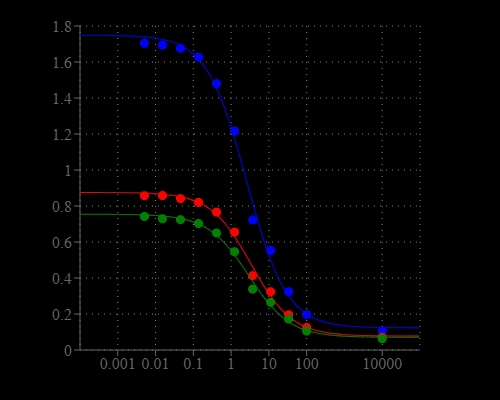Screen Quest™ Colorimetric ELISA cAMP Assay Kit
Adenosine 3’, 5’ cyclic monophosphate (cAMP) is an important second messenger in intracellular signal transduction. Monitoring levels of cAMP is one of the most common ways to screen for agonists and antagonists of GPCRs. Screen Quest™ Colorimetric ELISA cAMP Assay Kit is based on the competition between HRP-labeled cAMP and non-labeled cAMP. HRP-cAMP is displaced from the HRP-cAMP/anti-cAMP antibody complex by unlabeled free cAMP. In the absence of cAMP, HRP-cAMP conjugate is bound to anti-cAMP antibody exclusively. However, the unlabeled free cAMP in the test sample competes for anti-cAMP antibody with the HRP-cAMP antibody conjugate, therefore inhibits the binding of HRP-cAMP to anti-cAMP antibody. Our Screen Quest™ Colorimetric ELISA cAMP Assay Kit provides a sensitive method for detecting adenylate cyclase activity in biochemical or cell-based assay system. Compared to other ELISA cAMP assay kits, our kit eliminates the tedious acetylation step. The kit uses Amplite® Green as a colorimetric substrate to quantify the HRP activity. The assay can be performed in a convenient 96-well or 384-well microtiter-plate format.


| Catalog | Size | Price | Quantity |
|---|---|---|---|
| 36370 | 1 plate | Price | |
| 36371 | 10 plates | Price |
Storage, safety and handling
| H-phrase | H303, H313, H333 |
| Hazard symbol | XN |
| Intended use | Research Use Only (RUO) |
| R-phrase | R20, R21, R22 |
| UNSPSC | 12352200 |
Instrument settings
| Absorbance microplate reader | |
| Absorbance | 405, 650, or 740 nm |
| Recommended plate | Clear plate (Component F) |
Documents
Contact us
| Telephone | |
| Fax | |
| sales@aatbio.com | |
| International | See distributors |
| Bulk request | Inquire |
| Custom size | Inquire |
| Technical Support | Contact us |
| Request quotation | Request |
| Purchase order | Send to sales@aatbio.com |
| Shipping | Standard overnight for United States, inquire for international |
Page updated on December 16, 2025
